Public Health
Vote for L.A.’s official condom
June 20, 2012
One entry has the Hollywood sign spelling out the word CONDOM. One depicts a prophylactic stretched over Los Angeles’ iconic City Hall. Some have palm trees. Some have movie themes. Some are in Spanish. One features the Capitol Records building with the caption, “Let’s Get It On.”
The contest to select an Official L.A. Condom—or at least its wrapper—is off and running. A panel of judges is winnowing the entries, and, starting this week, the public will be able to vote online.
“We had more than 300 entries the last time I checked,” says Department of Public Health Project Manager True Beck. “On June 21, the semifinalists will be posted, and then the public will pick the top 10.”
Winners will be announced on June 26.
The contest, entitled “L.A.’s Next Sex Symbol,” is intended to promote safer sex and discourage the spread of HIV, syphilis, gonorrhea and other sexually transmitted diseases. A similar contest several years ago in New York generated widespread publicity.
The issue is serious—some 2,000 new HIV infections alone occur annually in Los Angeles County—but the contest’s tone has been anything but somber. The tag line is “Show Us Your Package,” and judges include the colorful gossip blogger Perez Hilton. Earlier this month, buff men in muscle shirts were on hand at the Downtown Art Walk to do condom demonstrations on popsicles and bananas.
Beck says the idea is to keep the conversation “light and sexy and fun”, and engage the public. The number one vote getter will win a television and $750 in gift cards, and the nine runners-up will receive $200 in gift cards.
The real prize, however, will be bragging rights: The 10 top designs will appear for the next year on the wrappers of a million and one free condoms handed out all over the county by the Department of Public Health.
Click here to see the entries and vote from June 21-26 for your favorite semifinalist, or go to LASexSymbol.com.
Posted 6/20/11
Calling all condom designers
May 17, 2012
There are a million free condoms in the naked city, and the Los Angeles County Department of Public Health sees a branding opportunity in that.
In an effort to help curb sexually transmitted diseases, the department’s Division of HIV and STD Programs this month will announce a contest to design an official L.A. condom wrapper to help brand the free prophylactics the county distributes to local businesses, social services and healthcare providers. Ads will invite county residents to come up with “L.A.’s Next Sex Symbol.”
“Our tagline is going to be ‘Show Me Your Package’,” says Project Manager True Ann Beck.
The lighthearted derby is part of a serious push in Los Angeles County to consolidate public health outreach on sexually transmitted diseases. An estimated 2,000 new HIV infections occur annually in L.A. County. Last year, the department reported more than 47,500 new cases of chlamydia, more than 9,500 new cases of gonorrhea and nearly 1,800 new cases of syphilis.
Each year, grant money is distributed by the county to local health care providers to purchase and distribute free condoms, which help prevent sexually transmitted diseases. (About 250,000 have been handed out so far this year, at a wholesale price of about six cents apiece, Beck says.) The contest is a small part of a larger centralization of STD prevention that has already merged three county programs.
The design contest, which will run from May 21 to June 17, will be facilitated by KCBS Marketing with help from the county’s condom wholesaler, Boston-based One Condoms, Beck says. Entrants must be Los Angeles County residents over the age of 18.
Rules will be posted on the contest web site (LASexSymbol.com), but generally, entries cannot be trademarked, copyrighted or sexually explicit. The winner and nine runners-up will receive prizes and gift cards, plus bragging rights to a package design that will be distributed countywide and featured in future condom promotions. All ten will be produced and distributed.
“We want to circulate more than one design so people can collect them all,” Beck says, adding that the initial plan is “to start with a million and one condoms.”
Updated 6/14/12: Learn more about the contest at the Downtown L.A. Art Walk tonight. Check out the 40-foot RV parked at 24 Main Street.
Public health officials note that contests are only one way among many to raise awareness and improve Southern California’s health. Still, New York’s 2010 contest attracted nearly 600 entries, persuaded New Yorkers to cast more than 15,000 online ballots and conferred momentary celebrity on the graphic artist who submitted the winning wrapper design—a graphic representation of a high-tech power button.
Beck says the hope is that the entries will be so smart and lively that the public won’t think of the free condoms as a government program.
“It’s going to be very light and sexy and fun. We’ll probably get all sorts of comments, but the point is to get people talking, and to get them to practice safer sex,” she says.
Posted 5/17/12
Putting the squeeze on Lap-Band ads
December 20, 2011
County supervisors squared off Tuesday with promoters of the Lap-Band, featured on billboards all over Southern California but drawing increasing attention from officials concerned that the publicity blitz is obscuring a wide range of medical dangers.
After a series of sharp exchanges with representatives of 1-800 GET THIN, supervisors approved a motion by Supervisors Mark Ridley-Thomas and Zev Yaroslavsky to bring greater scrutiny to Lap-Band marketing and procedures. They directed county staff to, among other things, “develop a plan to identify medical products and services that are being marketed in a dangerously misleading manner.”
The supervisors’ action comes after the U.S. Food and Drug Administration recently sent letters to eight Southern California weight loss clinics and the 1-800 GET THIN marketing firm, warning that the company’s ubiquitous advertisements do not provide enough information about the risks of gastric bypass surgery or about the need to change eating behavior to lose weight over the long term.
“The FDA’s warnings raise significant concerns about the vulnerability of all County residents to these advertisements, particularly those who suffer from morbid obesity and wish to find a cure,” the motion said. “Medical experts and the FDA agree that the Lap-Band procedure is an aggressive treatment for obesity and should only be considered in clinically severe obesity cases.”
Robert Silverman, the president of 1-800 GET THIN, told supervisors that his firm is taking steps to bring its billboards and radio and TV spots into compliance with the FDA requirements. An attorney for the company said its surgery centers “have a better track record than just about anybody else.”
But supervisors were openly frustrated as they tried to find out more about how 1-800 GET THIN operates, in terms of referrals to clinics and responsibility for disclosing risks to potential clients.
“It’s been a long time since a witness or member of the public has come to that table and has obfuscated as consistently and persistently as you have today,” Yaroslavsky told the 1-800 GET THIN representatives. “I did not come here as a person who had any fundamental suspicion one way or the other about what you were doing. I leave here now thinking you are hiding something.”
The FDA’s action was prompted by Dr. Jonathan E. Fielding, the county’s top public health official, who last year asked the agency to investigate whether widespread Lap-Band promotion by 1-800 GET THIN was misleading.
The motion approved by supervisors Tuesday directed the Public Health Department to report back on what it is doing to get the word out about “safe and effective alternative methods to achieve and maintain a healthier weight.”
“There is no panacea for obesity, including the Lap-Band weight loss procedure,” the motion said. “However, there are proven strategies, when sustained over time, which can help people achieve a healthier weight, and decrease the risk for diabetes, heart disease and other chronic diseases.”
The motion also directed the County Counsel to provide legal options on steps the county could take to “ensure truthful advertising of aggressive obesity treatment procedures in unincorporated areas.” And it instructed the Chief Executive Office to pursue legislation to increase supervision and oversight of clinics that perform “aggressive and invasive obesity treatment cosmetic procedures.”
Posted 12/20/11
Backpack? Pencils? Pertussis vaccine?
August 16, 2011
 As September approaches, health officials are reminding parents that a new state law requires proof of a pertussis, or whooping cough, booster for students entering the 7th through the 12th grades.
As September approaches, health officials are reminding parents that a new state law requires proof of a pertussis, or whooping cough, booster for students entering the 7th through the 12th grades.
The law was passed last year after a dramatic increase in pertussis cases sent the incidence of the disease soaring in California to the highest levels since 1958. More than 9,000 cases were reported, including 10 deaths, most of which were among infants who had not yet been vaccinated.
According to the Los Angeles County Department of Public Health, four of those babies were in Los Angeles County, where the number of reported pertussis cases quintupled to nearly 900. In normal years, no one dies of the disease.
More commonly called whooping cough, pertussis is a serious and highly contagious respiratory infection that causes violent, uncontrollable fits of coughing and can lead to pneumonia and brain hemorrhages, among other complications. Although most children receive a vaccination, known as Tdap, before kindergarten, the immunization can wear off, and children can remain susceptible into adulthood without booster shots in adolescence.
The incidence of pertussis has risen nationally in recent years along with measles, mumps and a number of other potentially lethal childhood illnesses. To complicate matters, unfounded fears about vaccine safety have been fueled by internet rumors, leading some states to make it easier for parents to opt out of vaccinations that used to be an iron-clad requirement for school enrollment. This, in turn, decreases resistance in the general population, as the proportion of the community immunized against these dangerous, but preventable, diseases falls below the required critical mass.
The new law does allow very limited exemptions, and includes a 30-day grace period allowing schools to let students attend classes if they don’t have their paperwork in order by the first day of class. But the school district still has to work with the family to get the child vaccinated before the final deadline because even if an unvaccinated child survives an infection, he or she can pass it to more vulnerable people, such as infants, the elderly and the ill.
Although 2011 rates have dropped and no deaths have been reported so far this year, the California Department of Public Health reports that whooping cough remains at higher-than-average levels in the state—and higher than the last record year, in 2005.
Parents whose middle- and high-school children have not yet been vaccinated should contact their health care provider. The Los Angeles Unified School District has been offering free vaccines this month, along with a number of community groups. For a list of places to go in Los Angeles County for free and low-cost immunizations, click here and here. For more information from the county Department of Public Health, click here. For information in Spanish, click here.
Posted 8/16/11
Food trucks start making the grade
February 3, 2011
You follow them on Twitter and dine on their increasingly eclectic curbside offerings, from Cuban medianoche sandwiches to passionfruit-flavored Hawaiian shaved ice.
Now you can be the first one on the block to spot that bright new letter grade in the window.
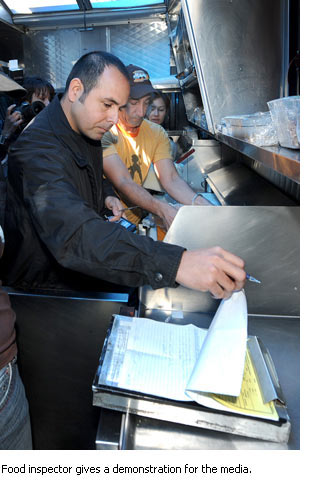 In January, Los Angeles County’s new letter-grading system took effect for mobile food vendors with the goal of making it easy for curbside diners to find out whether their favorite truck is passing muster with the Public Health department.
In January, Los Angeles County’s new letter-grading system took effect for mobile food vendors with the goal of making it easy for curbside diners to find out whether their favorite truck is passing muster with the Public Health department.
Today, public health officials demonstrated what goes into an inspection, using the popular Grilled Cheese Truck as an example. (It passed with a perfect 100%.)
“Once again, Los Angeles County is at the vanguard of the food safety industry,” Supervisor Zev Yaroslavsky said in helping to kick off the demonstration. (See press conference here.)
The ordinance to extend restaurant-style letter grades to food trucks, the first of its kind in the nation, was approved by the Board of Supervisors last October.
There are currently about 6,000 permitted food trucks in the county. From their construction site and factory yard origins, the trucks in recent years have expanded to serve a new clientele hungry not just for tacos and hot dogs but also for more exotic delights like Indian snacks served “desi” (curbside) style or Asian fusion plates.
Still, one of the trucks’ major assets—mobility—had also posed a potential headache for customers wondering who owns and operates the trucks, who inspects them, and whether their food is safe to eat.
Even before the advent of letter-grading, food trucks—like other restaurants in Los Angeles County—were subject to inspection and evaluation by public health authorities. (Here’s the detailed food-truck inspection guide, and all inspection records must be made available to customers upon request or posted online here.)
County officials worked closely with the Southern California Mobile Food Vendors Association in refining the new program; here’s the list of their members. Many of them have websites, Facebook pages and Twitter feeds to keep current and potential new customers up to date on schedules and routes.
Meanwhile, as food trucks’ visibility has increased, conflicts have sometimes cropped up between the mobile facilities and brick-and-mortar restaurants.
A task force convened last fall recently offered a series of recommendations to address concerns on both sides.
At today’s demonstration, Dr. Jonathan E. Fielding, the county’s director of Public Health, said the new food truck letter-grading program builds on the public popularity of the county’s restaurant program, which went into effect in 1998.
He said the program had proven extremely effective in reducing foodborne illness in the county—a benefit that now has wheels attached.
The video below is from today’s Press Conference – Mobile Food Facility Grading Program Launches in LA County:

Posted 2-3-11
Top county doc wants lap band ad probe
December 8, 2010
L.A. County’s top public health official wants to put the squeeze on those ubiquitous LAP-BAND ads.
In a Dec. 7 letter to the U.S. Food and Drug Administration, Dr. Jonathan E. Fielding asks the agency to investigate whether widespread promotion of the LAP-BAND by the 1-800-GET-THIN weight loss clinics is misleading the public by failing to disclose enough about the potential risks of such surgery.
Fielding, the county’s director of public health, said while bariatric surgery can be appropriate for some severely obese patients, it’s not for “the vast majority of individuals, and should be reserved for those who have failed other approaches.”
He also took aim at the assertion in the advertising campaign that “Diets fail!” which he said undercuts the importance of healthy, common-sense lifestyle choices.
“Misleading advertisements erode the ability of the majority of the public, who are currently either overweight or obese, to fairly consider alternative weight management options, and for ‘normal’ weight individuals to be concerned about behavior that increases risk of weight gain,” Fielding said in the letter.
Fielding’s letter comes as Allergan, which manufactures the LAP-BAND system, is seeking approval to broaden the use of its product by allowing less obese people to use it. Lowering the standards to include people with a body mass index of 35, or 30 if they have other conditions, could mean more than 2 million people in L.A. County would be eligible for such surgery, Fielding said. Currently, most patients must have a body mass index of at least 40, or 35 with certain other conditions, or be more than 100 pounds overweight, to be considered eligible for LAP-BAND surgery.
An FDA advisory panel last week voted in favor of the proposed expansion to less obese patients.
Anyone who’s driven or watched television in Los Angeles County has likely seen the billboards and bus ads touting LAP-BAND and heard the 1-800-GET-THIN jingle. A sampling of the ads were included with Fielding’s letter to the FDA.
Misleading promotional messages, especially if the device becomes available to more people, may prove to be a disincentive to maintaining a healthy lifestyle because they create the “false impression that there is a very simple, fast, effective and permanent fix” for weight loss, Fielding said
In an interview, Fielding said one purpose of his letter is to have the FDA clarify who bears responsibility for fully disclosing any potential risks associated with a medical device.
A spokeswoman for Allergan said her company had no role in the billboard and current TV advertising campaigns. “Allergan doesn’t control, manage or have any input on those ads,” said spokeswoman Cathy Taylor, who said her company would not comment on others’ promotional efforts involving the device.
Representatives for 1-800-GET-THIN could not be reached.
Fielding’s letter was directed to Dr. Herbert Lerner, acting director of the FDA’s Reproductive, Gastro-Renal and Urological Devices Center for Devices and Radiological Heath.
Fielding urges Lerner to take steps to ensure that the LAP-BAND promotional campaign “does not constitute misbranding of a restricted device.”
Fielding is not alone in voicing concerns about the potential expansion of the device’s use. Others, including the National Women’s Health Network, a nonprofit advocacy group, and the National Research Center for Women and Families also have raised questions. Before voting in favor of the proposed expanded use for the LAP-BAND, the FDA advisory panel heard testimony from New York attorney Stephanie Quatinetz, whose 27-year-old daughter died after LAP-BAND surgery.
Posted 12/8/10
Coliseum rave continues—with strings
December 2, 2010
Responding to wide concerns over the safety of raves, the Los Angeles Memorial Coliseum Commission this week told event promoters they must seek the panel’s approval at least 60 days before their next scheduled show at the historic facility.
The commission action came in lieu of reinstating a ban on the highly popular electronic music festivals that was put in place after the overdose death of a 15-year-old girl at last June’s Electric Daisy Carnival at the Coliseum. The two-day event, which drew 185,000 fans, prompted emergency medical officials to call for an end to the shows because of the high numbers of Ecstasy-related drug overdoses.
Following the girl’s death, the nine-member joint county, city and state commission adopted a moratorium on raves, proposed by County Supervisor Zev Yaroslavsky, a member of the panel. Yaroslavsky on Wednesday proposed that the board require the Coliseum staff and Electric Daisy Carnival promoter to seek the commission’s approval at least 60 days before the next show in June.
The commission will examine plans to ensure the safety and health of attendees. Many of those measures are detailed in a series of recent recommendations by the county’s public health department.
The commission will also study the impact of the festival in determining how to move forward. “If we can’t control it,” Yaroslavsky said, “then the promoters are going to have to find another place.”
On Tuesday, the Board of Supervisors is expected to vote on a motion by Yaroslavsky and Supervisor Don Knabe to adopt the series public health department recommendations, the product of a multi-jurisdictional task force.
You can read more about the Coliseum Commission’s action in these accounts from the Daily Breeze and the Los Angeles Times.
Posted 12/2/10
Hepatitis A alert for deli patrons
December 2, 2010
Public health officials are urging shots for anyone who ate a sandwich from Jerry’s Deli in Westwood on certain dates in November, after an employee there came down with hepatitis A.
The dates are November 18, 21, 23 and 24. The public health department said those who may have been exposed should get an immune globulin shot or a hepatitis A vaccination no later than 14 days after their exposure to prevent or reduce illness.
People who ate food other than sandwiches aren’t considered to be at risk. Only the Westwood branch of Jerry’s Deli is affected.
Affected diners should contact their personal physician promptly about getting a shot. If that’s not possible, immune globulin and hepatitis A vaccine are also available at some county clinics through Dec. 8. For more information, call 211 or click here. The Department of Public Health also has compiled this Q&A.
Posted 12/2/10
Before you tuck into turkey, read this
November 18, 2010
Jean Tremaine would like to interrupt the coming feeding frenzy with a public service announcement:
Thanksgiving dinner is a meal, “not an all-you-can-eat buffet that starts in the morning and goes through the weekend.”
Not that Tremaine, director of the county’s public health nutrition program, wants to be a turkey day buzz-kill.
By all means, she says, enjoy those once-a-year specialties. (Especially if depriving yourself at dinner means you’ll make up for it with a chocolate binge at home later.)
But come in with a game plan. Eating strategically is more than just a way to strike a blow for eating sanity at a meal that can easily weigh in at 3,000 calories or more.
It’s also a chance to create a healthy eating pattern for all of the holiday temptations ahead.
“Heading into the overeating season, it’s a good opportunity to set the tone and come out of this relatively unscathed,” says Tremaine, a 23-year county veteran whose department oversees nutritional education programs, helping to translate healthy eating practices into individualized approaches for L.A.’s ethnically diverse communities.
Otherwise, if you don’t watch it, “you’re in a food coma for the months of December and January.”
To stay out of that state—and to do your part to combat America’s obesity epidemic—here are a few of Tremaine’s tips for navigating the Thanksgiving bounty.
1. Know your must-have dish, and then take it easy on the rest.
“The most important thing to me is the pumpkin pie. My sister makes it. It’s just the classic recipe off the can, with a little more spices.”
2. Concentrate on the people around the table.
“Enjoy the socializing and not focus so much on the food. It’s called thanks giving. Think about what’s good in your life.”
3. Divide and conquer your dinner plate.
Load half your plate with vegetables (preferably not the kind that come doused in canned soup and topped with fried onions.) Leave one-quarter of the plate for turkey (no skin, please) and the rest for a starch of your choice. “Because there are so many simple carbohydrates, I skip some of them. I don’t need stuffing and mashed potatoes and a roll.”
4. Make the pre-dinner nibbles healthy.
“Normally, a Thanksgiving dinner starts hours before dinner.” Instead of “high fat dip, pretzels and peanuts,” offer guests seasonal fruit like sliced Fuyu persimmons, or a bowl of Satsuma tangerines.
5. Take it easy on the alcoholic beverages.
“Limit the booze. It’s high in calories and it lowers your eating inhibitions.” If you do imbibe, alternate your drinks with glasses of water.
None of this should make you think that Tremaine is some kind of joyless anti-food crusader. On the contrary, she’s the kind of person who enjoys seafood-eating vacations in places like Sicily or Sardinia. But, as a longtime Weight Watcher, she has learned how to combat a holiday tradition of “eat until you hurt.”
“A couple of decades ago, I stopped doing that,” says Tremaine, 63. “It’s a wonderful feeling not to eat until you hurt.”
And she thinks a less gluttonous approach can help people find more meaning in the holiday along the way.
“It’s really an occasion for reflection,” she says, “to ask ‘What am I grateful for?’ ”
For some other helpful hints, check out this turkey-carving video and make sure you’re up to speed on how to cook and serve your feast safely.
Posted 11/18/10




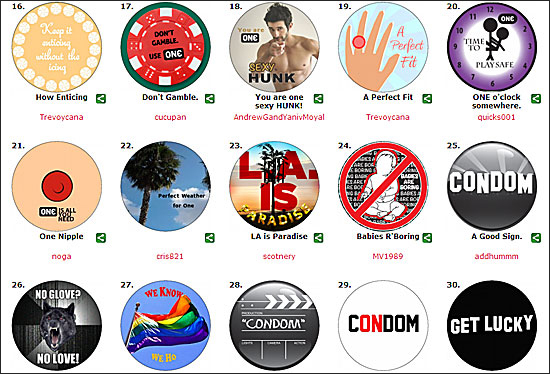




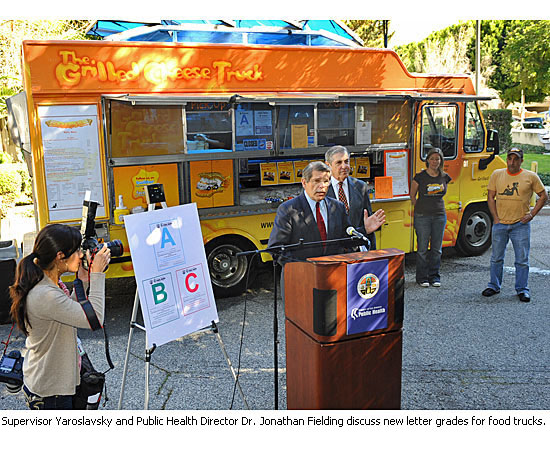
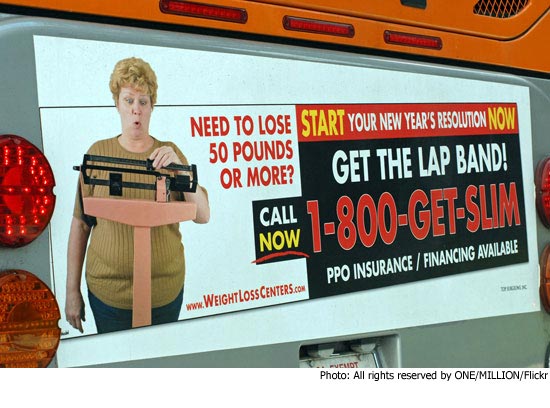

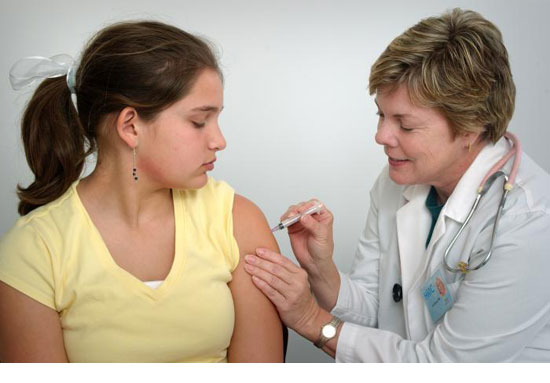

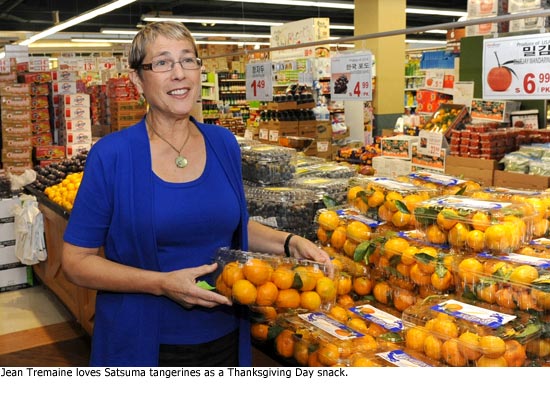







 405 bridge work causes a stink
405 bridge work causes a stink
